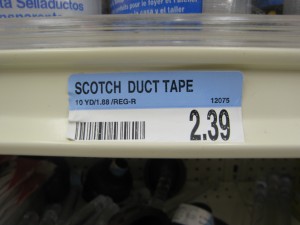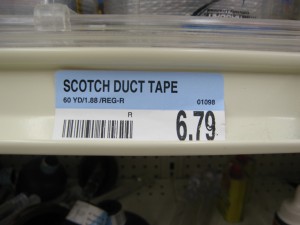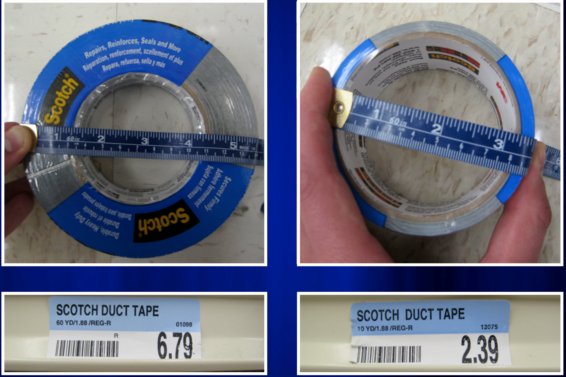Week in Lab: Focus on Unit Pricing
Due to minimum days, most of last week was an extension of last week, so rather than write about that, I’m going to focus on what I’ve done over the last few weeks in one grade level. The actual text and pictures for each lesson is at the bottom of the post. You can click on the links to see what the kids came up with to answer each lesson.
The first lesson set the stage. I asked them which of the tape rolls was cheaper. I didn’t ask them to do any math. To start, I asked them whole class what was in the picture that might help them figure this out. They named the price tag, the tape/ruler, etc. but I did not tell them what to look for, or which was important. This was about them figuring out what they thought they would need, but did not require or ask for any computation.
The next lesson circled around different ways for the students to think about which roll might be a better buy, by looking at how much tape they might need and how that would affect their decision. Once again, no computation was required, but some mental math was going to go a long way for kids answering the question.
The latest (but not the last) lesson is the first where I ask them a direct question that has a right/wrong answer and had them do some computation, but only in the most rough way. I did some modeling by asking them to shout out some answer to the last question, how much would it cost. I wanted them to see that I wasn’t looking for the EXACT answer, but saying $6 or $8 or $10 was fine (I know the first two are wrong, but you get the idea).
What is working? I think this has worked as an exercise in number sense, which students come out of elementary often very weak in. when I say “number sense” I mean it in a different way than the standards in my state express it (more around computation, less around what is a reasonable answer). The kid shouting out “99” as answer for any of the questions I posed is what I’m trying to avoid. The kid saying 12, when 10 is the closer to the answer is at least hitting it in the ball park. That’s what I want.
Where do we go next? My slow, deliberate pace has still not led to the ultimate goal, calculating unit pricing, but that is where this is heading. I like the slower pace in some ways because it is building background. My concerns…I could never go this slow in a regular classroom due to time, and the pacing schedule. This is not a problem for me, but a more global problem. My other concern is that very soon, the kids are going to be tired of looking at those damned pictures of tape. I’m still thinking about the unit formula, and how to introduce it. I think rather than just handing it to them, I’ll talk about their prior work and how they’ve a lot of the work already, then show them a more “direct” method, and to think about how it could be useful.
Your thoughts, as always, are welcome.
Big thanks to Dan Meyer for the photos (which he has provided two years in a row, when I “lost” my electronic copy from last year), the whole idea of WCYDWT.
Lesson One
Lesson Two
 |
 |
|
10 yards for $2.39 |
60 yards for $6.79 |
What if I need only 8 yards of tape? Which will be cheaper or less money?
What if I need 50 yards of tape? Which one will be cheaper?
Lesson Three
10 yards for $2.39
What if I need 50 yards of tape? How many of these would I need to buy? About how much would it cost?





